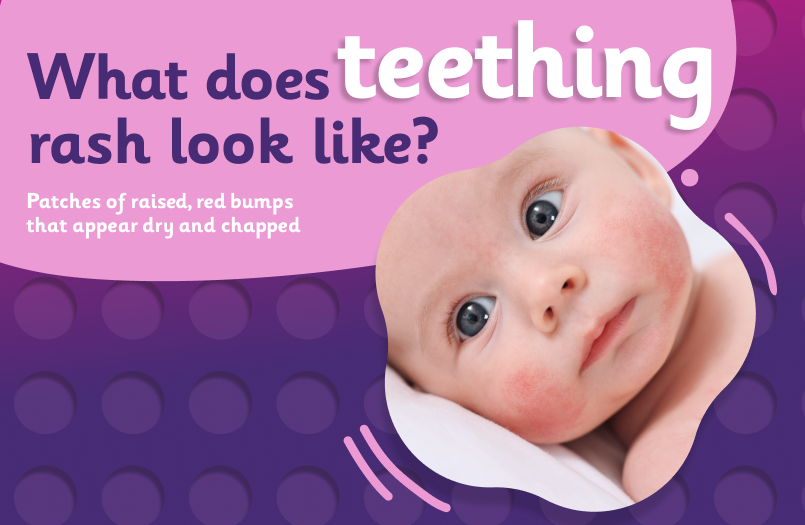The teething experience can be different for all babies, but most children will develop their first tooth within their first year1. New teeth emerging can cause an increase in salivation/drooling, which can lead to skin irritation and a teething rash2.
Here, we’ll explain what a teething rash is, what it looks like, and outline the teething rash symptoms, causes and treatment methods you can use to soothe your baby if it occurs.
What is baby teething rash?
A teething rash is a form of skin irritation caused by drool that can occur when a baby starts teething, not by the teething itself3.
Your baby’s new teeth will usually begin to emerge from their gums between 6-24 months of age. As these teeth come out, your baby will likely dribble a lot more. All this dribbling can irritate your baby’s sensitive skin and cause a rash. This rash is what is referred to as a teething rash or drooling rash2.

Teething rash symptoms
Often, babies start drooling at around six months, right around the time that their first tooth emerges from the gums. They can then develop a teething rash at any point as they start to drool a lot more2. This rash typically appears as small patches of raised, red bumps, and the skin may appear dry and chapped4.
Your baby can develop a teething rash anywhere on the body that drool gathers. This can include the2,4:
Chin
Cheeks
Neck
Chest A teething rash might not always occur and it’s normal for the condition to come and go4.
Causes of teething rash in babies
The cause of a teething or drooling rash is simple. As your baby drools more while teething, the saliva settles on your baby’s skin. This saliva, along with bits of food and constant wetness, irritate the baby’s skin, causing a rash4.
When combined with frequent rubbing on the skin from activities like hugging and playing, as well as their clothing, the teething rash can become persistent – but it’s usually harmless2.
Teething rash treatment options
If your baby has developed a teething rash, don’t worry – it’s usually treatable at home4. In most cases, the best solution is for you to limit the amount of contact between saliva and your baby’s skin. There are a few teething rash remedies you can try for this5:
Use bibs to catch drool
Gently wipe their face and chin, including the cracks on the side of their mouth to keep the area as dry as possible
Be careful not to over-wipe the area, as this can make it feel more sore
Apply petroleum jelly on the rash before bed and going out to help protect it from the elements An effective way of treating the pain caused by teething is the use of paracetamol or ibuprofen. CALPOL® Infant Suspension can be used for babies as young as two months to treat the pain associated with teething, while CALGEL® Teething Gel provides rapid relief from teething pain and is suitable from five months old.